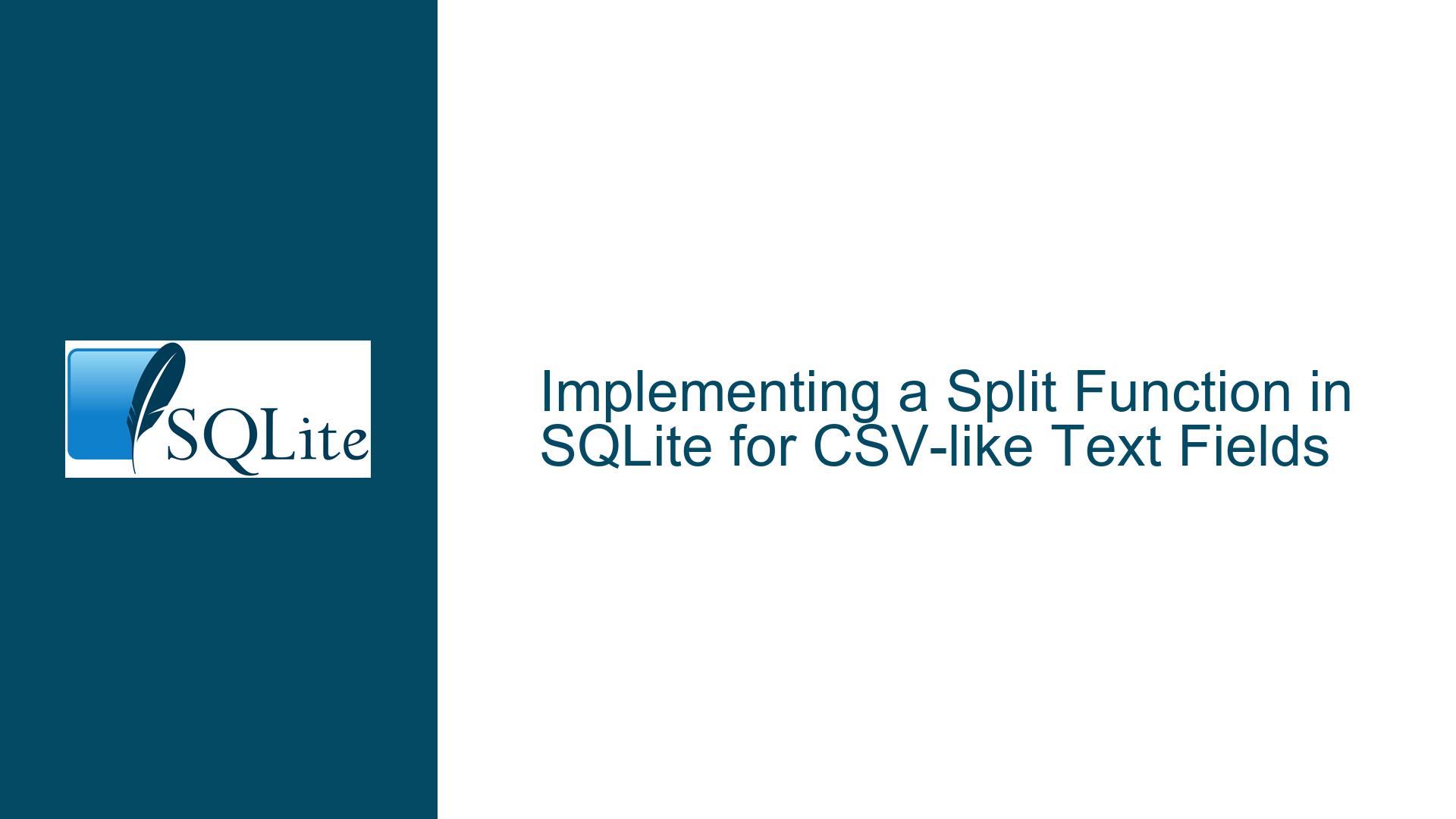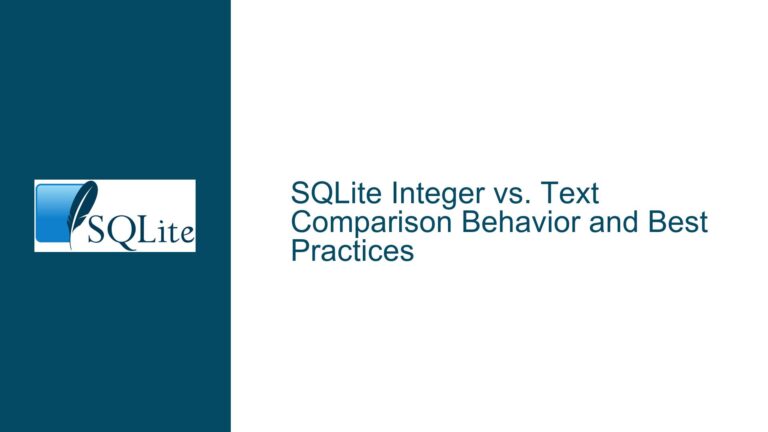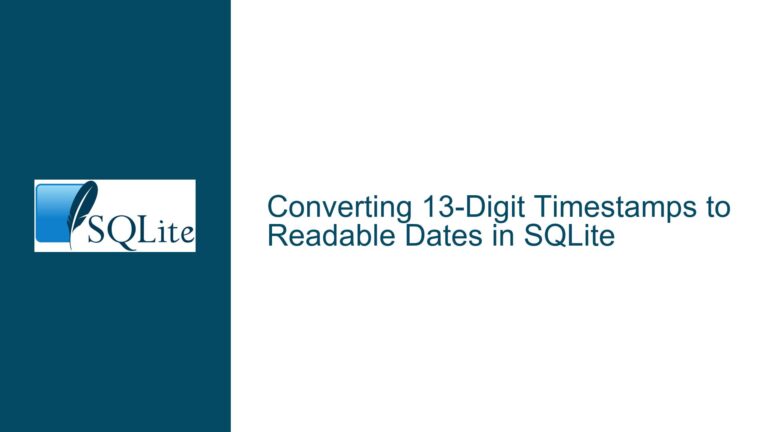Implementing a Split Function in SQLite for CSV-like Text Fields
Issue Overview: The Need for a Split Function in SQLite
SQLite, being a lightweight and versatile database engine, is widely used for its simplicity and efficiency. However, one of its limitations is the absence of a native array type, which often leads developers to use CSV (Comma-Separated Values) in text fields as a workaround. While SQLite provides the group_concat function to aggregate values into a CSV string, it lacks a built-in split function to reverse this process—splitting a CSV string back into individual rows. This limitation has been a point of contention for developers who need to manipulate and query data stored in CSV-like text fields.
The discussion revolves around the need for a split function that can take a CSV string and unnest its values into individual rows. This functionality is crucial for scenarios where data is stored in a denormalized format, and developers need to perform operations that require the data to be in a normalized form. The absence of such a function forces developers to resort to complex workarounds, such as recursive Common Table Expressions (CTEs) or leveraging the JSON1 extension, which, while functional, are not as straightforward or efficient as a dedicated split function would be.
Possible Causes: Why SQLite Lacks a Native Split Function
The absence of a native split function in SQLite can be attributed to several factors. First, SQLite is designed to be a minimalistic database engine, focusing on providing core functionality without bloating the system with features that may not be universally needed. The philosophy behind SQLite is to keep the database engine lightweight and easy to embed, which sometimes means omitting features that are considered non-essential.
Second, SQLite’s type system is intentionally simple, with only five basic types: null, integer, real, text, and blob. This simplicity is one of SQLite’s strengths, as it reduces complexity and makes the database more predictable. However, it also means that more complex data structures, such as arrays, are not natively supported. While the JSON1 extension allows for the manipulation of JSON arrays, this is not the same as having a native array type or a dedicated split function.
Third, the SQLite development team prioritizes stability and backward compatibility. Introducing new functions or features requires careful consideration to ensure that they do not break existing applications or introduce unexpected behavior. This cautious approach, while beneficial for the long-term stability of SQLite, can slow down the adoption of new features that the community may desire.
Troubleshooting Steps, Solutions & Fixes: Implementing a Split Function in SQLite
Given the lack of a native split function, developers have devised several workarounds to achieve the desired functionality. Below, we explore some of the most effective methods, ranging from recursive CTEs to leveraging external extensions.
1. Recursive Common Table Expressions (CTEs)
One of the most common approaches to splitting a CSV string in SQLite is using recursive CTEs. A recursive CTE allows you to perform iterative operations, which can be used to split a string based on a delimiter. Here’s an example of how this can be done:
WITH RECURSIVE split(value, remaining, sep) AS (
SELECT
'',
'here,are,some,words',
','
UNION ALL
SELECT
SUBSTR(remaining, 1, INSTR(remaining, sep) - 1),
SUBSTR(remaining, INSTR(remaining, sep) + 1),
sep
FROM split
WHERE remaining != ''
)
SELECT value
FROM split
WHERE value != '';
In this example, the recursive CTE split is used to iteratively extract each value from the CSV string. The SUBSTR and INSTR functions are used to find the delimiter and extract the substring before it. The recursion continues until the entire string is processed, and the final SELECT statement filters out any empty values.
While this method works, it has some drawbacks. Recursive CTEs can be computationally expensive, especially for large strings or when the recursion depth is significant. Additionally, the syntax can be cumbersome and difficult to read, making it less than ideal for frequent use.
2. Leveraging the JSON1 Extension
Another approach is to use SQLite’s JSON1 extension to manipulate JSON arrays. Although this does not directly provide a split function, it allows you to convert a CSV string into a JSON array and then use json_each to extract individual values. Here’s how you can do it:
SELECT value
FROM json_each('[' || REPLACE(json_quote('here,are,some,words'), ',', '","') || ']');
In this example, the CSV string 'here,are,some,words' is first converted into a JSON array by replacing commas with "," and wrapping the result in square brackets. The json_each function is then used to extract each value from the JSON array.
This method is more concise than using recursive CTEs and can be more efficient for certain use cases. However, it still requires additional steps to convert the CSV string into a JSON array, which may not be as intuitive as a dedicated split function.
3. Using the statement_vtab Virtual Table
For those who need a more seamless solution, the statement_vtab virtual table can be used to create a custom split function. This approach involves creating a virtual table that encapsulates the logic for splitting a string, allowing you to query it as if it were a built-in function. Here’s an example:
DROP TABLE IF EXISTS split;
CREATE VIRTUAL TABLE split USING statement((
WITH tokens(entry, data, sep, valid) AS (
SELECT
NULL,
:data,
:sep,
0
UNION ALL
SELECT
SUBSTR(data, 1, INSTR(data, sep) - 1),
SUBSTR(data, INSTR(data, sep) + 1),
sep,
1
FROM tokens
WHERE INSTR(data, sep) > 0
UNION ALL
SELECT
data,
NULL,
sep,
1
FROM tokens
WHERE INSTR(data, sep) < 1
)
SELECT entry
FROM tokens
WHERE valid = 1
));
With this virtual table in place, you can now use the split function to split a string into rows:
SELECT entry
FROM split('this is a list of space separated tokens', ' ');
This method provides a more elegant and reusable solution compared to recursive CTEs or JSON manipulation. However, it requires the creation of a virtual table, which may not be suitable for all environments, especially those with restricted permissions.
4. External Extensions: sqlite-lines
For those who prefer a pre-built solution, external extensions like sqlite-lines can be used to achieve similar functionality. sqlite-lines is an MIT-licensed extension that provides functions for reading and splitting strings based on delimiters. Here’s how you can use it:
.load ./lines0
SELECT rowid, line
FROM lines('a|b|c', '|');
This extension simplifies the process of splitting strings and can be a good option for those who need a quick and easy solution. However, it is worth noting that sqlite-lines does not currently support Windows due to the lack of the getdelim() function on that platform.
5. Combining Methods for Optimal Performance
In some cases, combining different methods can yield the best results. For example, you could use a recursive CTE for small datasets and switch to a virtual table or external extension for larger datasets. Additionally, you can optimize the performance of recursive CTEs by minimizing the number of function calls and using efficient string manipulation techniques.
Here’s an optimized version of the recursive CTE approach:
WITH RECURSIVE split(value, remaining, sep) AS (
SELECT
'',
'here,are,some,words',
','
UNION ALL
SELECT
SUBSTR(remaining, 1, INSTR(remaining || sep, sep) - 1),
SUBSTR(remaining, INSTR(remaining || sep, sep) + 1),
sep
FROM split
WHERE remaining != ''
)
SELECT value
FROM split
WHERE value != '';
In this version, the INSTR function is called only once per iteration, and the SUBSTR function is used more efficiently. This reduces the computational overhead and can improve performance for larger datasets.
Conclusion
While SQLite does not natively support a split function, there are several effective workarounds available. Recursive CTEs, JSON manipulation, virtual tables, and external extensions each offer their own advantages and trade-offs. By understanding these methods and their respective use cases, developers can choose the most appropriate solution for their needs and ensure efficient and effective data manipulation in SQLite.






